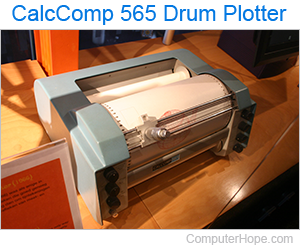Drum plotter

A drum plotter is a type of vector graphics printer that uses a cylindrical drum as the plotting surface (hence the name). In their prime, drum plotters were particularly popular for applications where high technical precision was required, such as architectural plans and engineering drawings.
While they were once widely used, drum plotters are mostly obsolete due to faster and more versatile devices like laser printers and flatbed plotters. These modern devices offer the convenience of producing text and graphics in a single device, making them more suitable for a broader range of tasks.
How does it work?
In a drum plotter, paper is mounted on a drum, which is then rotated using a motor. The plotting mechanism (often a pen or other drawing instrument) is mounted on a carriage that moves across the paper horizontally. Together, the precise placement of the writing implement, along with the rotation of the drum, creates lines and shapes on the paper. The drum's steady rotation allows a continuous plotting process, which is important for producing detailed and accurate vector graphics.
When was the first drum plotter released?
Released in 1959, the CalComp Model 565 was not only the first drum plotter, but one of the first output devices. Its drum could accept paper up to 11 inches in width, and its incremental movements were precise to 0.01 inches.
